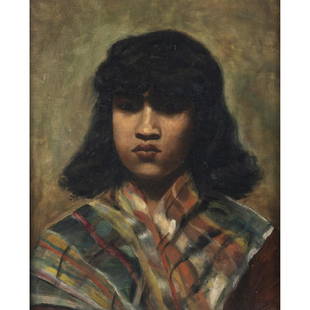
WOLFGANG PAALEN (1905 - 1959) Indian Summer Oil on canvas, 145 x 130cm Signed and dated (19)59;
Wolfgang Paalen Sale History
View Price Results for Wolfgang PaalenRelated Paintings
More Items from Wolfgang Paalen
View MoreRecommended Art
View More





Item Details
Description
WOLFGANG PAALEN (1905 - 1959) Indian Summer Oil on canvas, 145 x 130cm Signed and dated (19)59; inscribed and dated 1959 verso Provenance: John Huston Collection, St. Clerans, Co. Galway; Private Collection, Dublin The main concern is not to operate for eternity, but in eternity. (From Wolfgang Paalen’s scrapbook Voyage nord-ouest, Canada/Alaska 1939). Austrian born artist Wolfgang Paalen was a key figure across many movements that have come to define the artistic landscape of the mid-20th century. On relocating to Paris in the 1930s, Paalen joined the Surrealist group with his then wife and fellow artist Alice Rahon. Initially he was drawn to the creative possibilities of automatism, and this led to the development of his fumage technique. He used candle smoke to make distinct impressions on the surface of the oil painting, resulting in hazy, dreamlike images. Following an invitation from Frida Kahlo, Paalen left Paris in 1939 intending to visit her in Mexico. However, before heading south, he travelled by train across Canada arriving in British Columbia in June. From there he embarked on an expedition across the Indian reserves on the north-west coast, a journey which would spark a life-long interest in indigenous art. He finally arrived in Mexico in September, shortly after the outbreak of the war and joined the group of influential artists, including Frida Kahlo, Diego Riveria and fellow expat Leonora Carrington. In an attempt to bring together the disparate strands of surrealism spread across the different continents, he organized the International Exhibition of Surrealism in Mexico City with André Breton in 1940. This large-scale work, with its canvas covered in an array of bright spots of colour against a white background alludes to his own abstract language that he had developed since the 1940s. His farewell to Surrealism published in the inaugural edition of his interdisciplinary journal Dyn (1942 – 1944), was a public separation from the movement and allowed him to move towards a new experimental artistic approach to exploring the unconscious mind and to look to past and prehistoric cultures which had been traditionally overlooked in the artistic canon. Paalen used Dyn to express new theoretical concepts, such as his own ideas on totemism and totemistic art, new propositions on quantum theory as well as criticism of the philosophical concept of dialectical materialism and western dualism. Paalen was one of the most influential art theorists of the period and his impact on the genesis of Abstract Expressionism and the modern art movement cannot be understated. The Dynaton, as they named themselves were a group of artists from the San Francisco Bay Area including painters Gordon Onslow Ford and Lee Mullican. The word ‘Dynaton’ comes from the Greek ???? ?? ??????? – “that which is possible” and perfectly captures the character of this present work by Paalen. There is no sense of beginning or ending in the work. The tones swirl and swim across the canvas or gather in clusters applied in thick layers to enliven the texture of the surface. It expresses an idea of an eternal, never ending universe in which there is a circular, rather than linear, order to the cosmos. Everything is coming and going in an endless cycle. This work was painted in 1959, the year that Paalen died by suicide in Mexico after suffering for many years with bipolar disorder. As a late work it exemplifies a shift in his practice described by celebrated Mexican author Octavio Paz as a “florid tempest,” in which Paalen was inspired by the surrounding landscape of the Yucatan Peninsula. Other examples painted in same year use very similar vivid colour palettes and compositions such as Bougainvillea (Mildred Lane Kemper Art Museum, Washington University St Louis) or Migración de Yucatán (Museo de Arte Carrillo Gil, Mexico City). The title ‘Indian Summer’ may allude to the flower Alstroemaeria 'Indian Summer' or Peruvian Lily as it is more commonly known, reflecting the orange and yellow tones of its petals. Or it may even refer to the meteorological phenomenon of unexpected spell of warm weather in Autumn. Regardless of what determines its subject matter, it is a beautifully expressive painting that exemplified the intermittent but intensive periods of artistic productivity that characterised the final year of his life. Niamh Corcoran
Buyer's Premium
- 30%
WOLFGANG PAALEN (1905 - 1959) Indian Summer Oil on canvas, 145 x 130cm Signed and dated (19)59;
Estimate €40,000 - €60,000
8 bidders are watching this item.
Shipping & Pickup Options
Item located in Ireland, Dublin, ieSee Policy for Shipping
Local Pickup Available
Payment

TOP














































![[SEX] LOT OF 9 PHOTOGRAPHS SOLD TOGETHER: [SEX] A lot of 9 photographs sold together. Some postcards. One mounted with plastic corners in archival mat. Prints: 4.5" x 3" - 6" x 4". Generally good condition, various imperfections. *Additional](https://p1.liveauctioneers.com/8124/329546/177689790_1_x.jpg?height=310&quality=70&version=1715469494)

![Emilio Grau-Sala "Sur la Plage" Oil on Canvas: Emilio Grau-Sala (Spanish, 1911-1975), "Sur la Plage" [On The Beach], Oil on Canvas, 1958, signed "Grau Sala" lower right, signed, inscribed "Trouville", dated, and titled to verso. Image: 21.5" H x 2](https://p1.liveauctioneers.com/5649/328023/176731071_1_x.jpg?height=310&quality=70&version=1714409606)












